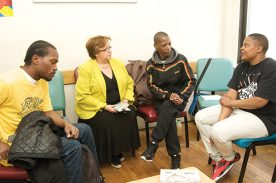
By Barry Benepe
Walking is both the expression of freedom and an embrace of space. An automobile driver is imprisoned in a mobile metal box. Amos Hawley, a professor of sociology at the University of Michigan said in 1962, “If it is true that life is lived largely on foot, that the deep and enriching experiences are had only in lingering associations…the decline in time spent as a pedestrian, while the…time spent in vehicular movement steadily mounts, may suggest an increasing casualness and irresponsibility in urban life.” A person in a vehicle is moved from place to place. A person walking moves from place to place with a maximum of free choice.
Bernard Rudofsky, who enjoyed a particularly deep awareness of city form, observed, “Above all is the humaneness of this architecture that should bring forth some response in us… Photographs can only hint at the actual experience of traversing passages through complicated spaces that play on all senses: sheafs of light-piercing darkness; waves of coolness and warmth; the echo of one’s own footsteps; the odor of sunbaked stones. The sum of these impressions adds up to an aesthetic adventure that, modest though it is, we are usually denied.”
The streets of Paris, which reflect a 1,000-year history and the passage of millions of footfalls, are largely spared the relentless walls of steel which have characterized Manhattan streets since the onset of automobile curbside parking in the 1930s. In Paris, the walls of stone buildings bond with stone pavement visible from both sides of the street. Thus, one has a clear definition of place.
In Manhattan, we have begun to open our historical living City to sensory experience. Spaces have been retaken from parked and moving cars and made available to those of us on foot and relaxing on seats at tables in landscaped surroundings. There, we can relax, read, converse, eat, drink, or simply snooze in the noonday sun. One of our longtime neighbors, former New York State Senator Whitney (Mike) North Seymour, Jr., once headed the New York Park Association, which lobbied successfully to legalize outdoor cafes to add to street life. Pop-up cafes and gardens have further enlivened streets at a human scale. We should continue reshaping our City to benefit those of us on foot.
Cardinal François Marty, Archbishop of Paris, preaching from Notre Dame in 1976 intoned, “The city requires a change in the rhythm of its life with more place for silence.”
This was echoed by An Observer in the City who stated, “I have a fantasy. One Spring Sunday, after due warning, the Mayor will declare a day of peace in the city without traffic…The joy of walking in a city will be discovered by hundreds of thousands [who] will discover the beauties of their own neighborhoods. They will come onto the intimate contact with history walking great distances through the city; and it will be incredibly peaceful. Forgotten sounds will be heard: a ship in the harbor, gulls, a purple finch, wind in the trees, children’s voices, human conversations, and street music. The smell of flowering shrubs or cut grass will be freed from the blanket of pollution. Walking will be a simple matter for the very young as well as the old and infirm. Bicycles will appear everywhere…It will be a calm day of simple pleasure and direct experience with immediate surroundings.” (That “Observer” may have been an anonymous New Yorker columnist in the 1960s.)
We should keep these thoughts in mind as we help shape our City.



